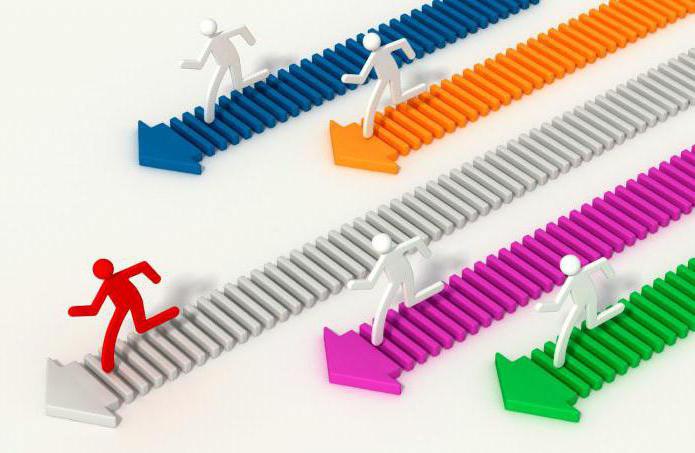Competition in the global sense is rivalry in one area or another in order to obtain greater benefits. Let us consider in more detail what competition is in economic terms, its types and examples. And also we will study how various types of economic struggle influence the market as a whole.
Deciphering the term
This concept exists in various fields, including biology, economics, law, etc. If you take the term from the perspective of the economy, then competition is the process of interconnection, interaction and struggle between enterprises in the market in order to provide yourself with the best opportunities for selling goods and services to meet the needs of customers .
Experts identified several functions of competition, among which:
- setting the value of products on the market;
- change in individual prices;
- redistribution of profits depending on the expended forces and energy;
- balancing the overflow of funds between industries and industries.
Varieties of competition
To correctly understand what competition is, one should also consider the classification of its types. The scale of development distinguishes the following types of economic rivalry:
- local (rivalry between entrepreneurs in a specific territory);
- individual (one market representative is trying to find the best trading conditions for himself);
- industry (in one of the industries there is a competition for the greatest profit);
- intersectoral (the struggle between representatives from different industries who seek to seize the buyer to their side and get more income);
- national (manufacturers compete among themselves within the same state);
- global (global rivalry between enterprises and even countries).
There is also a classification, the criterion for which is the nature of development. In this case, two type of competition: free and adjustable. In addition, economic competition is priced and non-priced. As for the price, here we are talking about artificially knocking down prices for specific goods. Non-price competition takes place when they improve the products themselves, improve manufacturing technologies, apply innovations and nanotechnologies. At the same time, goods are produced that are fundamentally different from their other older brothers.
Competition between enterprises
The competition of firms working in a particular field and wanting to get more profit requires certain actions from its employees. Among the areas of competitive activity of companies are the following:
- rivalry in the field of raw materials markets in order to gain a favorable position;
- competition in the sale of services or products;
- the struggle between buyers in the markets.
The rivalry of enterprises in the markets is usually studied in marketing. And what is competition in terms of marketing? This is a rivalry against the consumer, that is, the struggle for him at different stages of the selection and acquisition of goods. From here comes the breakdown of competition into species:
- Functional. It means that the same human need can be met in different ways.
- Intercompany The rivalry of alternatives and the most effective ways to meet needs.
- Desires are competitors. Before the buyer there are many different ways of investing.
- Intermarket. Here the products of the same manufacturer compete with each other.In this case, there is no competition as such, there is only an imitation of a huge selection of products for customers.
Perfect and imperfect competition
Depending on the prerequisites for the balance of competing parties, such types of competition as perfect and imperfect are distinguished in the market. Perfect competition is interpreted as a theoretical construction, or ideal. Used to develop an analysis and research methodology market structures.
Unlike the first, imperfect is based on various imbalances of a competitive nature. The characteristics of this type of economic rivalry include the distribution of the market between large companies or the complete dominance of one firm.
Imperfect competition in the market is represented by the following types: oligopolistic and monopolistic competition. The oligopolistic type implies a small number of competitors, serious market power, product similarity and a limited number of sizes. Basically, a similar market is present in the chemical industry, as well as the engineering industry, metalworking, etc.
The monopolistic type is characterized by many competing parties in the market, approximately equal forces, product differentiation. A monopoly market is being formed where competition is difficult due to technical features. An example is transportation, energy, telephone communications, etc.
Monopolies
Modern conditions of competition and features of market relations lead to the formation of monopolies. It can be considered in relation to any enterprise that has strong advantages in the production of services, goods, or work. Sometimes a monopoly is called a state of the market in which a certain group of commodity producers leads. Also, this term is meant when it comes to a special type economic relations. Their essence is expressed in the fact that one enterprise or union is capable of influencing other producers and imposing their will on them.
What is competition inherently when it comes to monopoly? This is a type of economic struggle, in which there is an increased market power and high entry barriers for new market players. The monopolist can dictate the prices of manufactured goods and appropriate high profits, as well as impose his will in drafting contracts that put competitors in unfavorable conditions in advance.
Types of Monopolies
Economists distinguish the following types of competition when it comes to monopolies:
- Natural or sustainable. Such a monopoly is possessed by owners in whose hands very rare resources that cannot be reproduced are concentrated.
- An artificial monopoly is specially imposed by some economic entity that keeps the objects of economic relations under control.
- Innovative. In this case, the monopolist wins due to the introduction of innovations in production, allowing to produce unique products.
The influence of monopolies on the market
Dry statistics show the fact that monopolies can both positively affect market relations and negatively. A positive impact on manufacturing companies is manifested in the fact that there is an opportunity to reduce unit costs, due to savings on the scale of production. Technological progress also takes place due to the high concentration of resources.
Negative influence is characterized by the fact that sometimes the elementary rights of consumers are grossly violated, which are put before the fact of an overpriced price with an understated offer. Imbalances in the development of the market appear, which ultimately negatively affects the quality of goods and services.






